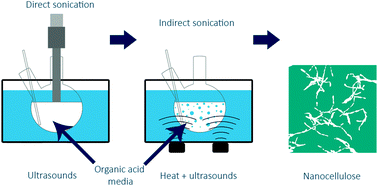Sonochemical production of nanoscaled crystalline cellulose using organic acids†
Abstract
The present work deals with the production of cellulose nanoparticles through sonochemistry in various organic acidic media. The use of such organic acids represents low-environmental harm for the process. In contrast, the use of induced cavitation during chemical reaction balances the low effectiveness associated with the hydrolysis that uses organic acids, related to their low acidity. Overcoming the costs associated with extensive use of reagents and long reaction periods, which result in high-energy requirements, gives the value-added potential to an intrinsically green process. The selected organic acids were oxalic, maleic, and citric acid, chosen for their nature and their acid dissociation constant, as well as their availability in nature, which makes them green and cheap acidic media to produce cellulose nanocrystals. The acid concentration used was 0.2 moles for all the reactions; however, the pH, temperature, and reaction time were variated. The yields ranged between 20 and 40% depending on the reaction conditions, which are similar to typical cellulose nanocrystals yields. On the other hand, physicochemical analyses showed little differences between the different cellulose nanocrystals, thus indicating that the main benefit of having longer reaction times relies exclusively on the production yield. The resultant CNC surface contained carboxylic acid groups, which facilitate functionalization and dispersion in aqueous processing.



 Please wait while we load your content...
Please wait while we load your content...